The Intel Optane SSD 900P 280GB Review
by Billy Tallis on October 27, 2017 9:30 AM ESTAnandTech Storage Bench - The Destroyer
The Destroyer is an extremely long test replicating the access patterns of very IO-intensive desktop usage. A detailed breakdown can be found in this article. Like real-world usage, the drives do get the occasional break that allows for some background garbage collection and flushing caches, but those idle times are limited to 25ms so that it doesn't take all week to run the test. These AnandTech Storage Bench (ATSB) tests do not involve running the actual applications that generated the workloads, so the scores are relatively insensitive to changes in CPU performance and RAM from our new testbed, but the jump to a newer version of Windows and the newer storage drivers can have an impact.
We quantify performance on this test by reporting the drive's average data throughput, the average latency of the I/O operations, and the total energy used by the drive over the course of the test.
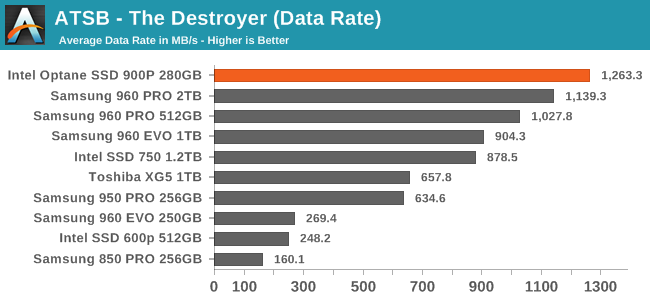
The Intel Optane SSD 900P sets a new record for average data rate on The Destroyer, beating the Samsung 960 PRO 2TB's score by about 10%, and beating the more similarly-priced 512GB 960 PRO by about 23%.
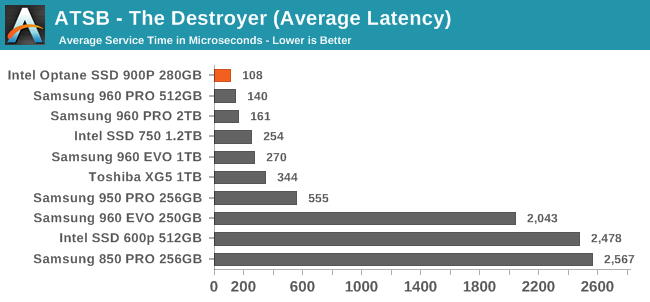
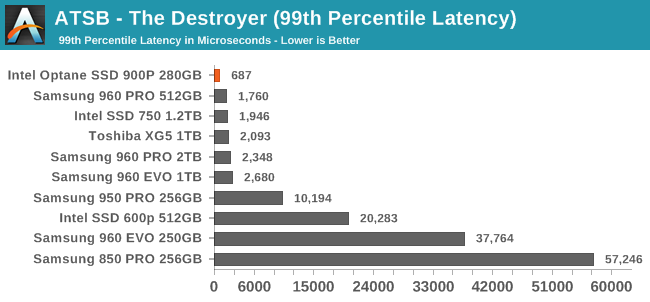
The average latency of the Optane SSD 900P on The Destroyer is a modest improvement over the previous record. The 99th percentile latency is a more significant 60% reduction over the previous record, putting the Optane SSD more clearly in a separate performance consistency class from high-end flash-based SSDs.
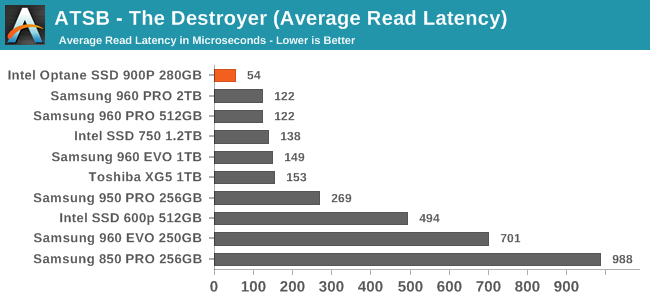
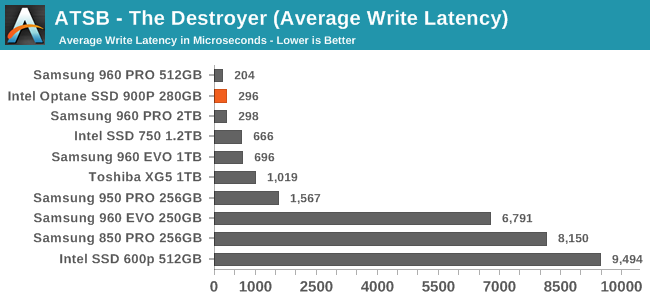
The average read latency of the Optane SSD 900P on The Destroyer is less than half that of any flash-based SSD, but the average write latency is a bit slower than the fastest flash-based SSDs.
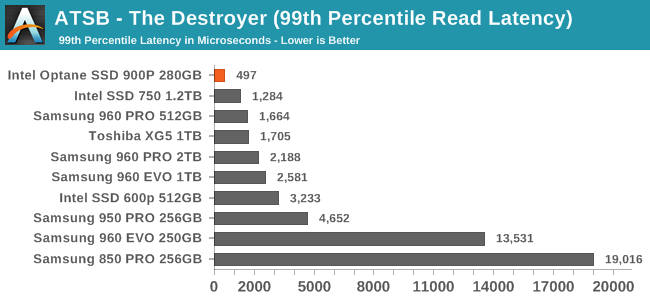
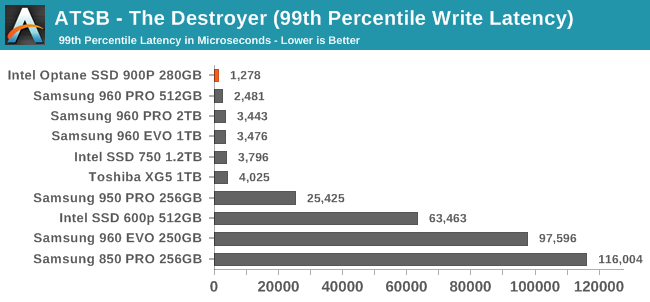
Even though the Optane SSD didn't set a record for average write latency on the Destroyer, its 99th percentile write latency is about half the previous record. The 99th percentile read latency beats the previous record by more than 60%.










205 Comments
View All Comments
ddriver - Friday, October 27, 2017 - link
I got myself a bucked of salt. The necessary requirement to swallow that Houdini "2.7x better" claim from the launch PR.I've been rendering stuff since the days of 3d max for frigging DOS. And I am yet to experience a scenario where CPU load is not in the 99% range.
Having a rendering job that cannot feed the CPU to above 10% load with the insanely fast 960 pro has got to be an unprecedented case of cooked-up benchmark in human history.
extide - Friday, October 27, 2017 - link
Did you read the article? It pretty clearly explains how they got that result, and it makes sense.ddriver - Friday, October 27, 2017 - link
Oh yeah, I get it. Hypetane is a synthetic beast. Which allows to showcase said advantage as long as you focus on it in a carefully devised and completely detached from real-world usage workload.Don't get me wrong. It is good that hypetane is now available in capacities that actually allow to use it. And if endurance turns out to be tangibly better than nand, I might actually buy it. Low queue depth performance is good, especially random read, which may not be of that much practical use to most of the people out there, but I could make good use of that.
But it will remain "hypetane" even after I go and buy it. Because intel said "1000 times better", and it is not even 10 times better. A zero on its own might be nothing, but two zeroes after a positive number make quite a lot of difference.
ddriver - Friday, October 27, 2017 - link
"no other alternative nonvolatile memory technology is close to being ready to challenge 3D XPoint"Except for SLC, which was so good it was immediately abandoned once inferior and more profit friendly NAND implementations were available.
A SLC based product coupled with MRAM cache will easily humiliate hypetane in its few strong aspects.
Too bad NAND drives are now moving to TLC and QLC, even MLC is heading in the "luxury item" category. Too bad because 3D SLC has tremendous potential. Let's see if it gets realized.
extide - Friday, October 27, 2017 - link
How would that work. SLC is slower than Optane, can't be written at a block level, needs trash collection, etc. Then you cache it with a technology similar to Optane? Why not just build a drive with all MRAM, oh yeah, too expensive. Looks like Optane wins.ddriver - Friday, October 27, 2017 - link
Nope, SLC is actually faster. Look it up.And what it cannot do is write at the bit level. Which is not really a big deal. Even CPUs cannot address RAM at bellow a byte, if you want single bit operations, you have to use bitwise operators. Writing at a higher level is actually very efficient, because it reduces overhead. If single bit addressing was important, that's who computers would work.
Furthermore, single bit writes produce a significant challenge when tracking wear levels. Hypetane still wears out, you know... It will be tremendously harder to accurately track wear at bit level, and I am abot 99.999999% sure it is not how intel does it, meaning that a lot of that supposed extra endurance will be forfeited by managing wear at a coarsely grained level. They won't be managing that at bit level, the overhead will be tremendous and will completely diminish potential advantages.
The MRAM cache will reduce a lot of write amplification and garbage collection.
It also looks like 3d SLC has about 3 times the density of the chips intel is currently using for hypetane.
"Why not just build a drive with all MRAM" - density is too low. Which is also why we use RAM for working memory, I mean volatility can easily be solved by say adding a RTG battery to a DRAM drive, giving it effectively about a century of continuous, uninterrupted power. It is doable, but then again, redundant, and while it is true that the industry does a lot of pointless things nowadays, the only ones that qualify are those with a desirable usability to profitability ratio, and a RTG DRAM drive is simply too good to offer...
"Looks like Optane wins" - anyone can win when running unopposed. The moment someone makes a SLC/MRAM hybrid and it loses to hypetane, I will retract my statement and admit I was wrong. I have zero problem with that ;)
vanilla_gorilla - Friday, October 27, 2017 - link
So you're saying Optane sucks because it would be slower than a drive that doesn't exist?ddriver - Friday, October 27, 2017 - link
No, I am saying it "sucks" because for all intents and purposes, it is not any faster than a 2 year old drive that it was supposed to beat by a 1000 times.And the reason I put it "sucks" is because I never said it does suck. I give it a very realistic valuation. What sucks is how far that realistic valuation is from what intel promised. Which is entirely on them.
name99 - Friday, October 27, 2017 - link
He's saying two distinct things.(a) This costs too much for what it delivers. IF Samsung wanted to compete with it, they could do so with a suite of existing technologies. But they probably won't do so because there is little demand for a product like this; honestly it only exists so that Intel can say "see, 3D-XPoint is too, real".
(b) The place where 3D-XPoint ACTUALLY makes sense is, more or less, what AnandTech says --- as a slower (but much larger) RAM replacement. That's what plays to the technology's strengths (simple controller, byte-level access). But Intel STILL are not shipping that --- which makes one wonder WTF not?
It IS reasonable to point out that Intel has been lying about this product since the day it was announced, and that the only reason they're shipping these SSD drives is to throw up more smoke to hide the fact that the actually sensible use case remains (for some reason) impossible.
Being a fanboy isn't about always praising your company, it's about refusing to criticize your company even when they're clearly in the wrong. Intel is clearly in the wrong here, in the sense that nothing that they promised about Optane is actually reality even today, two years after the announcement.
If you think that's reasonable behavior, ask yourself how you would react if your favorite villainous company did the same.
Would you be impressed if AMD announced that they're going to ship a GPU 1000x faster than the competition, and two years later all they have is something 2.7x as fast (under very specialized circumstances)?
Would you let Apple off the hook if they said that the Apple car was going to have 1000x the range of a Tesla, then they shipped two years later, a car with 2.7x the range of a Tesla?
Drumsticks - Saturday, October 28, 2017 - link
Re: AMD example: if AMD claimed a product would be 100x or 1000x faster than Nvidia, but only delivered something 6-10x faster in the majority of cases, and on par in the rest, for only 2-3x more money, I'd still be pretty satisfied.